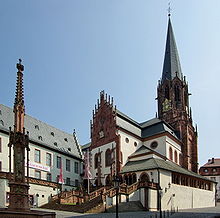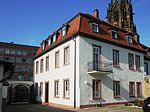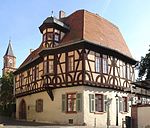Collegiate courts in Aschaffenburg
The colleges (curiae, vicarages) were the seats of the canons of the collegiate chapter St. Peter and Alexander in the Aschaffenburg upper town. The focus was on the collegiate church and the chapter house.
history
Aschaffenburg was the seat of the upper monastery in the ore monastery Kurmainz .
The spiritual body at the collegiate church was the collegiate monastery , a community of secular canons . A provost presided over the chapter . His residence was the provost's office . In 1588 Jodocus Cammerer resigned as provost and became dean . The dean's task was to lead the services and to exercise disciplinary authority over the clergy who did not belong to the chapter. His collegiate court was the deanery . In order to be included in the chapter, the canon had to be in possession of a court or a curia. The vicars had to look after the side altars, their vicarages were named after the chapels. In the 16th century, all curia houses were owned by the monastery.
The monastery was dissolved through secularization . With a contract dated December 22, 1808, Karl Theodor von Dalberg gave the assets of the monastery to the Aschaffenburg University as the legal successor to the University of Mainz as a perpetual foundation . This is still managed today by the Aschaffenburg Foundation Office.
Colleges
- "Zur Rose" abbey house
- Mentioned in 1317 as Zur Rose at the "Kuria bei St. Peter", today the rectory of St. Peter and Alexander Stiftsgasse 5 (old house number: Lit. A No. 17)
- Abbey House "Zum Einbeck"
- 1340 owned by canon Konrad Schwab, in 1355 it was acquired by canon Johann von Einbeck, today the seat of the foundation administration - foundation office Aschaffenburg, Stiftsgasse 7 (old house number: Lit. A No. 18)
- Stiftshof "To the old coin"
- 1160 owner Wilemann der Münzer, until 1333 Johann von Aschaffenburg, canon of St. Stephan Mainz, belonging to the monastery since 1464, built in 1751 as a prebend house "Zur alten Münze" by Johann Georg Wenzeslaus von Hoffmann and donated to the monastery, made dean around 1803 Also known as the "Salm'sches Palais", today the seat of Stadtbau Aschaffenburg GmbH, Stiftsgasse 9 (old house number: Lit. A No. 19)
- Abbey house "To the mulberry tree"
- In the possession of the monastery since 1411, today the town hall of the city of Aschaffenburg, Stiftsgasse 2, today Dalbergstraße 15 (old house number: lit. A No. 14)
- "Hasenfurt" Abbey House
- Property of Canon Heinrich von Hasenfurt until 1275, today the town hall of Aschaffenburg, Stiftsgasse 4, today Dalbergstraße 15 (old house number Lit. A No. 15)
- "Pistorei" of the pen
- 1144 Founding of the monastery bakery, belonging to the monastery until 1811, today the town hall of the city of Aschaffenburg, Stiftsgasse 6, today Dalbergstraße 15 (old house number: Lit. A No. 16)
- Vicarie S. Mariae in Aegypto
- Mentioned in 1413, owned by the monastery from 1626 to 1823, was the home of the first theater director Joseph Schemenauer (1811–1817), Stiftsgasse 8 (old house number: Lit. A No. 29)
- "Zum Hawen" abbey house
- Mentioned for the first time in 1341 as "Zum Huge" in the possession of the monastery dean Heilmann Schwab. Demolished in 1969 and rebuilt as a half-timbered house in the old style, Stiftsgasse 10 (old house number: Lit. A No. 28)
- "Zum Trappen" abbey house
- Since 1443 the benefice house of the monastery (curia), Stiftsgasse 12 (old house number: Lit. A No. 27)
- Abbey house "Zum Fraß" also "Betzelin Hof"
- Pfründehof, owned by the monastery since 1322, today a home for the elderly of the Aschaffenburg Hospital Foundation, Stiftsgasse 14 (old house number: Lit. A No. 26)
- Vicarie S. Johannes Evangelista u. S. Leonhard
- Mentioned in 1615, demolished in 1641, owned by the monastery from 1615 to 1838, dead end 3a (old house number: Lit. A No. 20)
- Vicarie S. Michael
- Demolished in 1673 as a house in a sack , garden property , dead end 5 (old house number: Lit. A No. 20 1/2)
- Abbey house "Amöneburg" also "Zum Stiefel"
- 1367 owner Franz von Möneburg, Pfründehaus, owned by the monastery from 1382 to 1868, new building in 1601, since 1911 Antoniusheim, cul-de-sac 4 (old house number: lit. A No. 22)
- Stiftshaus "Colonia" or "Lützelkirch"
- In 1367 the canon Nikolaus von Lützelkirchen acquired the property and called it "Colonia - Kleine Kölle" or "Lützelkirch", belonging to the monastery from 1400 to 1820, since 1911 Antoniusheim, dead end 6 (old house number: Lit. A No. 21)
- Vikariehaus St. Nikolaus
- The vicarie existed until 1450 and was then united with "the court of the nuns of Smerlinbach". In 1754 the house was sold, Pfaffengasse 4 (old house number: Lit. B No. 4)
- "Schmerlenbacher Hof"
- Since 1339 the nuns from Smerlinbach (Schmerlenbach) had their town house here (old house numbers: Lit. B No. 4a and Lit. B No. 5)
- Vicariehaus St. Andreas
- In the possession of the monastery vicar Heinrich Schwab until 1339, owned by the monastery from 1339 to 1815, completely destroyed in 1944, Pfaffengasse 8 (old house number: Lit. B No. 6)
- Curia "To the Hole" or "To the Monkey"
- Mentioned in 1374, Hartmann Schwab gives interest to the monastery, owned by the monastery from 1402 to 1812, "Curia zum Affen" since 1568, totally destroyed in 1944, Pfaffengasse 10 (old house number: Lit. B No. 7)
- "Unterglöcknerhaus", "Zum Stege" or "Zum Rebstock"
- Before 1338 it belonged to the vicar Heinrich Schwab, from 1338 it belonged to the monastery, completely destroyed in 1944, Pfaffengasse 12 (old house number: lit. B no. 8)
- Vicarie St. Margerethe
- Belonged to the monastery from 1566 to 1809 and inhabited by vicars, completely destroyed in 1944, Pfaffengasse 14 (old house number: Lit. B No. 9)
- Vicarie St. Catherine
- Belonged to the monastery from 1566 to 1809 and inhabited by vicars, totally destroyed in 1944, Pfaffengasse 16 (old house number: Lit. B No. 10)
- Vicarie St. Michael in ambitu
- On the city wall, belonging to the monastery from 1566 to 1834 and inhabited by monastery vicars, demolished in 1979, Pfaffengasse 18 (old house number: Lit. B No. 11)
- "To the Rannenburg", "To the Rannenberg"
- Until 1307 belonging to the knight Johannes von Rannenburg, 1307 vicar Johann Kraft, until 1338 vicar Heinrich Schwab, 1341-1392 the nobleman Herdan von Alpach and his descendants, 1392-1827 owned by the monastery, 1836 to the general school and study fund, broken off in 1860, Pfaffengasse 20 (old house number: Lit.B No. 12)
- Propstei or preposition house
- Pfaffengasse 15 (old house number: Lit B No. 22)
- Predicature house
- Schlossgasse 24 (old house number: Lit. B No. 24)
- Vicarie St. Nicola
- Schlossgasse 20 (old house number: Lit. B No. 26)
- Abbey House "To Little Egypt", Curia "Stecklenberg" and Curia "To the 11,000 Virgins"
- Demolished in 1612 and the Jesuit Church and Jesuit College (study seminar) built on it, Pfaffengasse 22, 24 and 26 (old house numbers: Lit. B No. 13, Lit. B No. 14 and Lit. B No. 15)
- Curia "Zum Bienbach" - "Stäblerhaus"
- The house was considered to be one of the oldest in Germany. The Romanesque stone building went back to the last quarter of the 12th century. A farm with stone house in Aschaffenburg is mentioned for the first time in the document from 1181. From 1315 to 1832 it was owned by the Stiftsstäblers (master of ceremonies) and home, the house was destroyed by bombs on December 21, 1944. Pfaffengasse 5 (old house number: Lit. B No. 16)
- Curia "Zum Freudenberg"
- 1399 House of the canon and canon Nikolaus Freudenberg, belonging to the monastery from 1549 to 1833, residential building Pfaffengasse 7 (old house number: Lit. B No. 17)
- Vikariehaus St. Thomas and St. Margarethe
- Erected in 1422, publishing house since 1928, "Main-Echo" publishing house from 1950 to 1980, today Pfaffengasse 9 (old house number: Lit. B No. 18)
- Curia "Zur Rübe", "Rübenhof"
- In 1350 canon Hermann Rapa "Rübe" sold a curia to canon Johann von Trier. Belonged to the monastery from 1422 to 1828, demolished, new building in 1867, publishing house since 1896, city administration since 1980, Pfaffengasse 11 (old house number: Lit. B No. 19)
- Curia St. Elisabeth, "Reifer" or "Reifen" and "Vikariehaus Holleberg"
- The "Deutschhaussaal" was built in 1812 on the associated garden property with barn and in 1835 Karlsplatz was laid out.
- "Dekanei", "Alte Dechantei"
- Belonged to the monastery from 1315 to 1824, from 1824 to 1920 "Casinosaal" (Casino Society Aschaffenburg) since 1920 Evangelical Lutheran parish, Christ Church, today Bachsaal, Pfaffengasse 13 (old house number: Lit. B No. 20)
- Curia "To the great Christoph"
- Already owned by the monastery before 1570 to 1824, since 1920 Evangelical Lutheran Church Congregation, Christ Church, today the parish hall (center), Pfaffengasse 15 (old house number: Lit. B No. 21)
- Curia "To Schelmen", "Schelmenhof"
- Stiftsscholastiker Gerlach Schelm bequeathed the monastery courtyard to his nephew, Canon Johann Schelm. From 1308 to 1830 the curia belonged to the monastery. A school building was built there in 1831 and the Christ Church in 1837 . The school building destroyed in the war was not rebuilt. Today there is the rectory, Pfaffengasse 15 and 17 (old house numbers: Lit. B nos. 22 and 22 1/2)
-
- Curia "Zum Keulenberg"
- In 1798 merged with the Wartenberg Curia to form the Starkenburg Curia, first mentioned in 1317, before 1432 it belonged to the monastery
- Curia "Wartenburg", "Wartenberg"
- In 1798 merged with the “Zum Keulenberg” curia to form the “Starkenburg Curia”, from 1322 to 1827 it belonged to the monastery and was named as:
-
- "Starkenburg" Curia
- First mentioned in 1798, the reconstructed half-timbered building with its bay window and turret has been the property of the Evangelical Lutheran Church Community of Aschaffenburg, Pfaffengasse 19 (old house number: Lit. B No. 23) since 1956
- Abbey house "Zur Wurzlade"
- Mentioned as vicarious house of the monastery as early as the 13th century, mostly referred to as vicarial house by the Michaelskapelle, belonging to the monastery from 1408 to 1820, no longer existent, plot of land Fl. No. 433 Gem. Aschaffenburg opposite the Theaterklause restaurant, (old house number: Lit. B No. 35)
- Stiftshof "Zum Würzgarten"
- Mentioned in a document in 1331, from (1542–1589) “Collenberger Hof”, (1612–1714) “Dalberger Hof”, (1744–1803) “Coming of the Teutonic Order”, “Grand Ducal privileged theater” (1811), since (1851) City Theater Aschaffenburg , Schlossgasse 8 (old house number: Lit. B No. 31)
- Abbey House "St. Martin "
- Mentioned in 1577 as the vicarage house "Sti. Martini", in 1613 it no longer existed. Schlossgasse 12 (old house number: Lit. B No. 30)
- Curia "Zum Greif (f) enstein", "Greif"
- In 1338 in the possession of the Stiftscholasters Heilmann Schwab, in 1610 in the possession of the Archbishop of Mainz Johann Schweikhard von Kronberg (in his capacity as provost of the Aschaffenburg monastery), here was the house of Georg Ridinger , the builder of Johannisburg Castle , rebuilt in 1803 by Michael and Wolfgang Streiter for Archivrat Urban Müller (Metzgergasse 11 and 13) as well as Webergasse 4, 1804/05 rebuilt by Wolfgang Streiter (old house numbers: lit. B no. 48 1/2, lit. B no. 48 1/4 and lit. 51 1/2)
See also
Aristocratic courts in Aschaffenburg
literature
- Alois Grimm: Aschaffenburg house book. Volume I: Dalbergstrasse-Stiftsgasse-Fischerviertel. Geschichts- und Kunstverein eV, Aschaffenburg 1985, ISBN 3-87965-007-3 .
- Alois Grimm: (Monika Ebert, Peter Fleck, Ernst Holleber et al.): Aschaffenburger Häuserbuch Volume II: Old town between Dalbergstrasse and the castle, Mainufer-Mainbrücke-Löherstrasse. Geschichts- und Kunstverein eV, Aschaffenburg 1991, ISBN 3-87965-053-5 .
Individual evidence
- ^ August Amrhein: The prelates and canons of the former collegiate monastery St. Peter and Alexander zu Aschaffenburg. P. 218.
- ↑ Alois Grimm: Aschaffenburg house book. Volume I:
- ^ Alois Stadtmüller: Aschaffenburg in the Second World War - bombing, siege, handover. Publications of the history and art association Aschaffenburg iK Paul Pattloch Verlag, Aschaffenburg 1970. (1987, ISBN 3-87965-040-3 )
- ↑ Alois Grimm: Aschaffenburg house book . Volume II:










